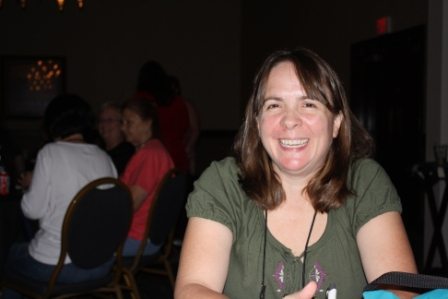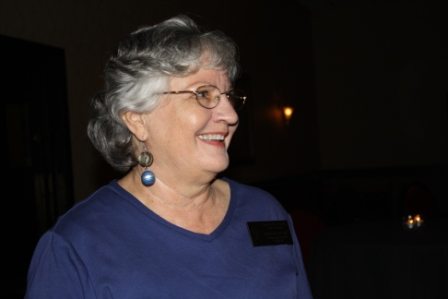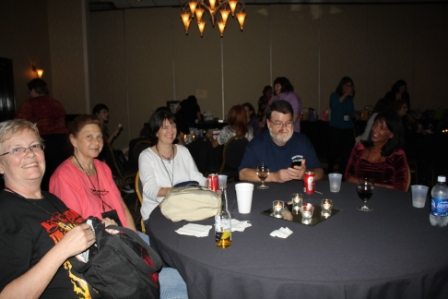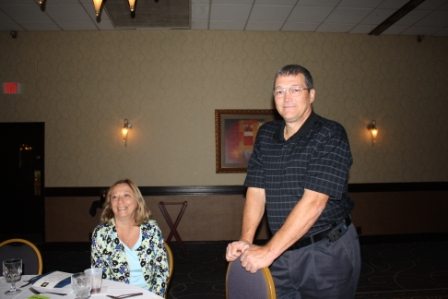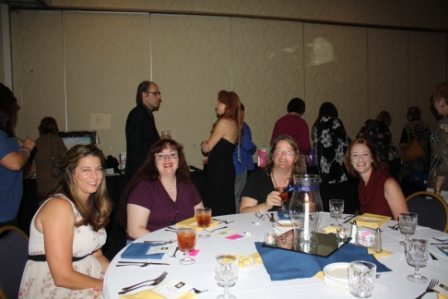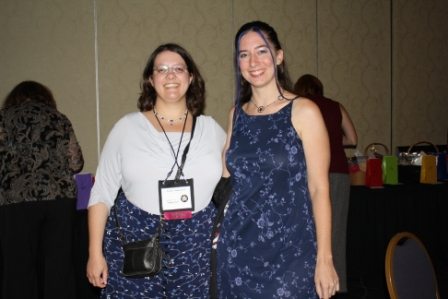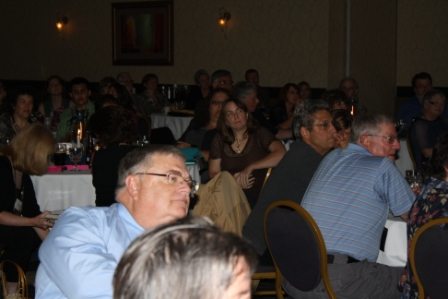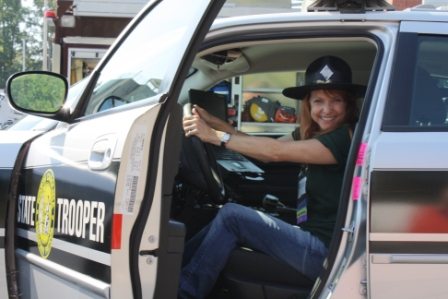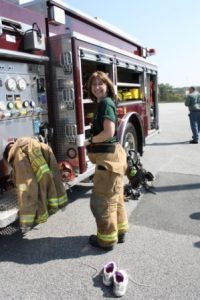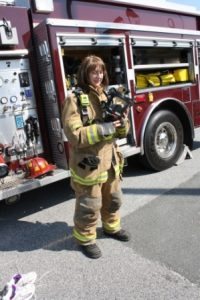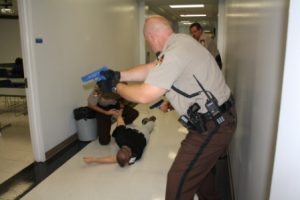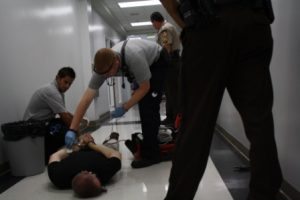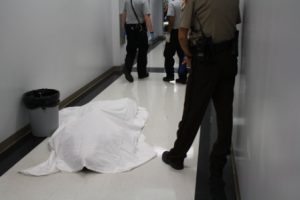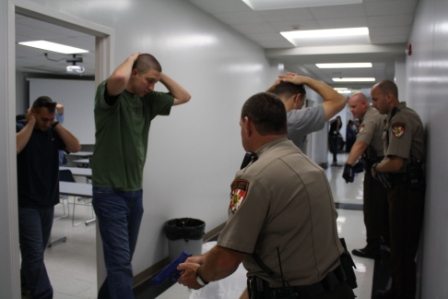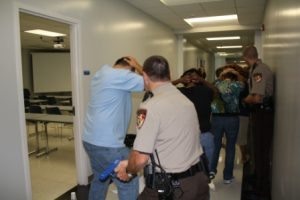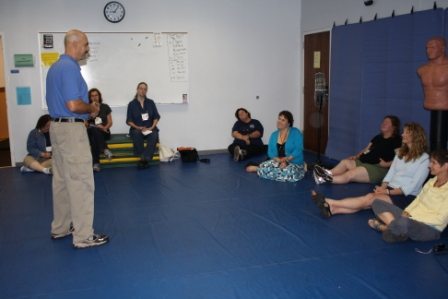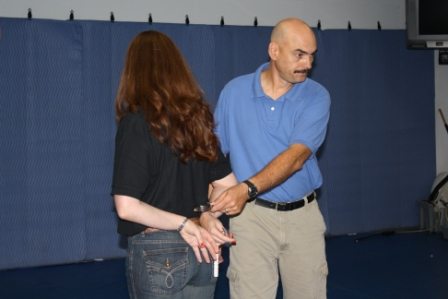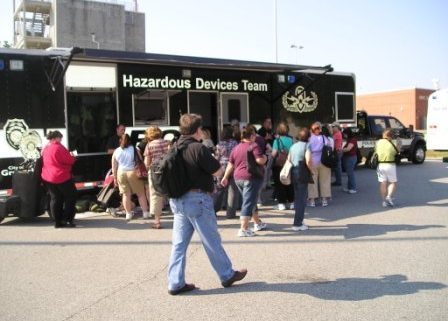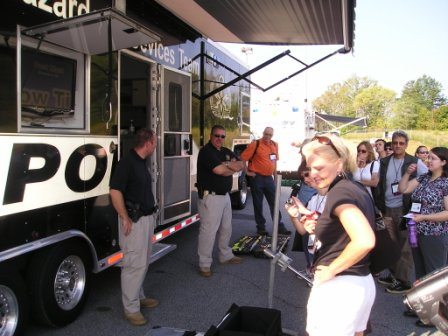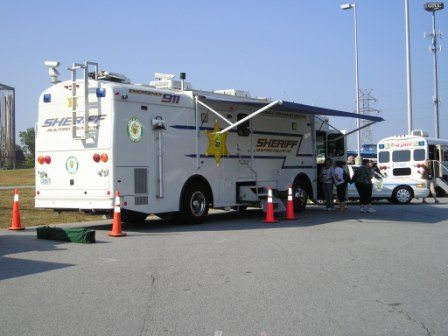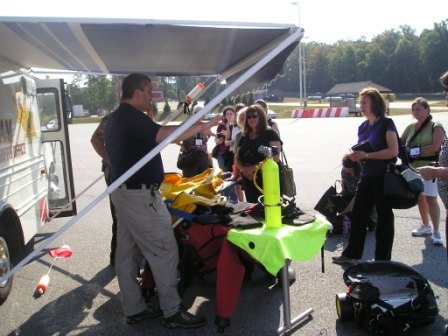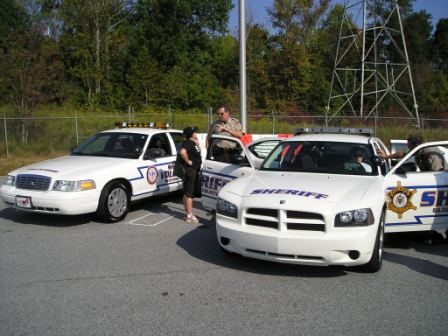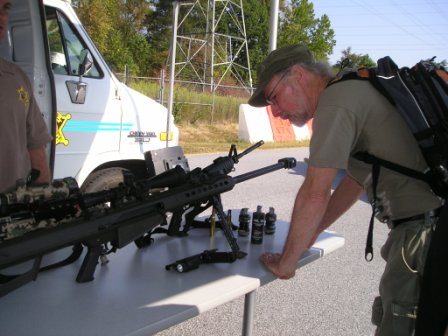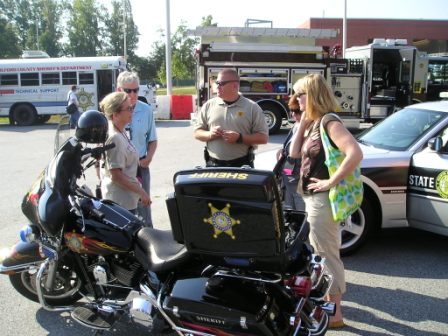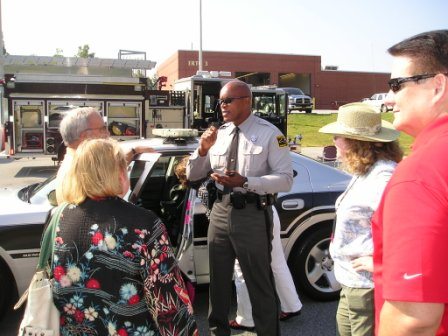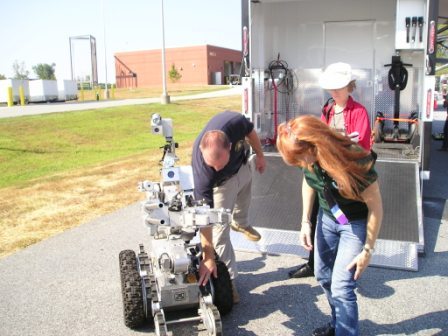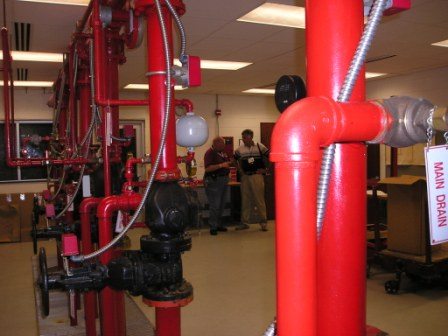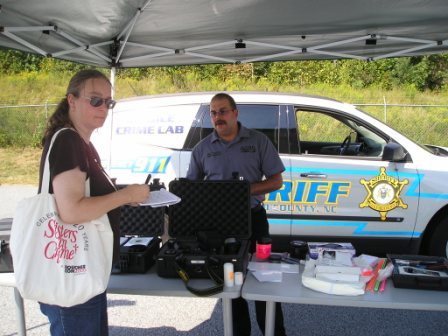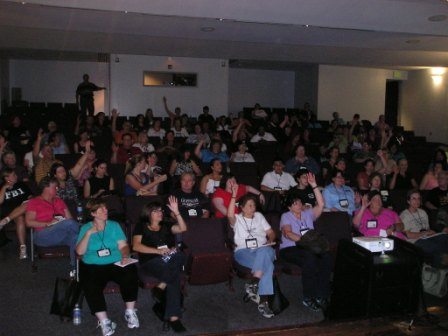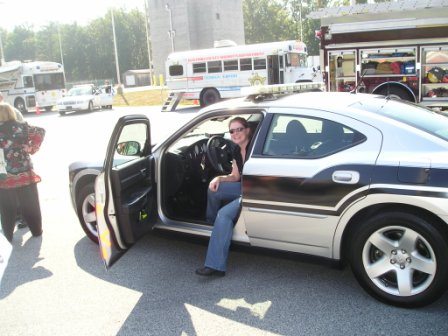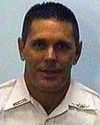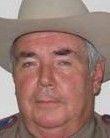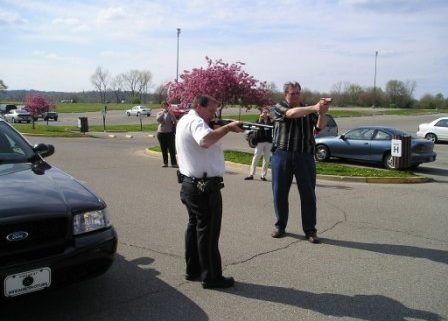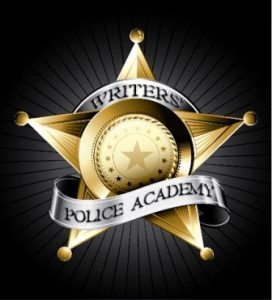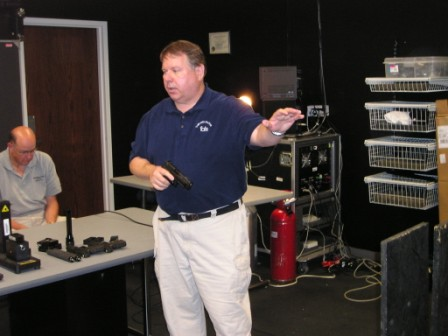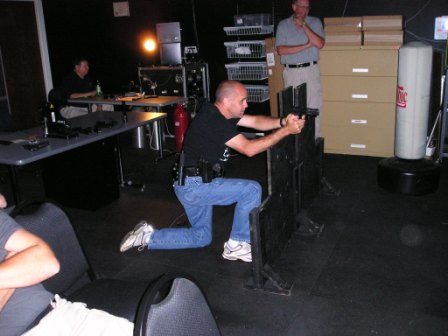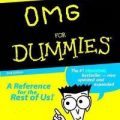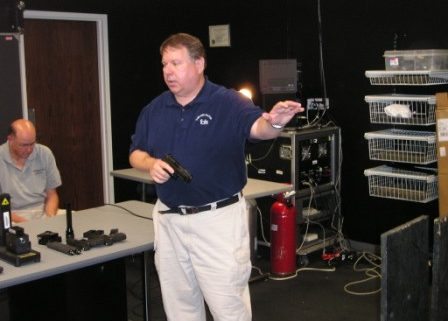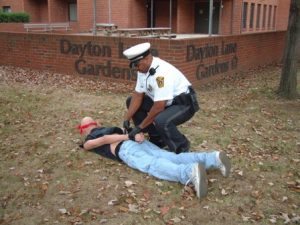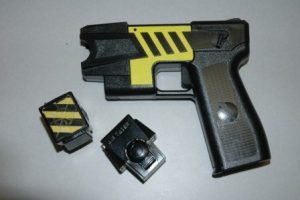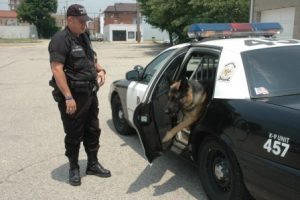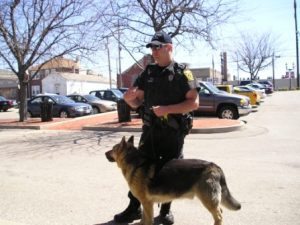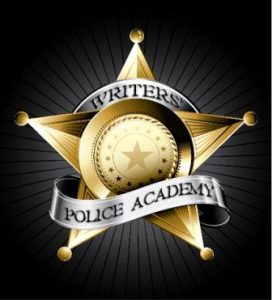This is one entry team no criminal wants to face. WPA recruit Rebekah Aidukatis, ATF Special Agent Rick McMahan, and the master of the twisted ending himself, Jeffery Deaver, made quick work of drug dealers and other armed thugs during the WPA FATS training. When these three entered a building you knew they were there and that they meant business.
Criminal justice instructor Bill Lanning was described by the recruits as AWESOME. That’s pretty much his opinion of the Bone Collector, as well.
Firing an M-4 using three-round bursts, Deaver found his targets with laser-like accuracy. This guy can really shoot!
WPA organizer and my guardian angel, Nancy Metzner, was mother hen to all. Here she looks on, I’m sure, to see to it that Jeffery Deaver had no problems during his training.
Instructor Stan Lawhorne helps a recruit and first-time shooter. We called her “Number 4” because many of her rounds (marked by a number 4) were often found landing in unusual places, like tree tops, street signs, and generally any place where the bad guys weren’t. She was a great sport and by the time the training was over she’d found her mark. Learning to shoot is difficult enough, but she learned the hard way—in the dark, under stressful conditions, and with moving targets.
Julie Goyette (WPA staff), Jeffery Deaver, and Nancy Metzner look on as EMS personnel treat a shooting victim in the academy hallway.
Verna Dreisbach, Jeffery Deaver, Lee Lofland, and Marco Conelli at the Friday night meet and greet reception.
* * *
Writers’ Police Academy photo of the day!
Sophie Littlefield in an “arresting” pose.

Is it over yet? That was my reaction ten minutes into this episode. As much as I normally enjoy the show, I must say this particular episode was exactly what I needed to take the final edge off the leftover Writers’ Police Academy adrenaline high. Sure, everyone looked nice, there was a dead body, and Det. Ryan even had a couple of spotlight moments (is it just me or he is beginning to really stand out as a key player in this show?), but there simply wasn’t enough to keep me interested. I actually fell asleep a few times while attempting to watch. It was sort of like going to a rock concert where the headliner is a band from the 70’s that plays all the chords and sings all the right lyrics, but there’s no life in the performance. They’re tired. And Castle and Beckett looked tired this week.
Or was it the writer who blew this one for me? Let’s look back at another episode written by Moira Kirkland. Tick, Tick, Tick was a two-part episode and here’s my opening comment from the first week’s review:
Tonight’s episode is the first of a two-parter, and I have to admit I’m thankful the network broke this particular show into segments. Why? Because there’s no way I could stomach this all in one sitting. The writers definitely went for over the top stupid this time.
So maybe the actors had nothing to work with this week. Anyway, on with the show…

– We start with a woman who found her mother’s dead body inside a sleeper sofa with an ice pick protruding from her neck—pointed end embedded into the flesh. I’m not sure how much room was inside the sofa, but there had to have been a lot because the weapon stood straight out. Wouldn’t a normal sleeper sofa mattress be tightly compressed, which wouldn’t allow the weapon to be so perfectly placed for the viewing audience? Not a big deal…just an observation.
– When the daughter opened the sofa her mother’s body rolled out and flopped into view like a wet fish. A few minutes later Lanie Parish states the body was in full rigor, therefore, it should have been as unyielding as a fireplace poker. Or, was the queen of all psychic pathologists looking into the future. Sure, that’s it. She had a brief flash. Maybe she’d just watched Chuck and a little of his abilities cross-contaminated the two networks.
Voodoo doctor Parish also went on to say:
1. No scratches on the metal part of the ice pick. Why’d she say that? Was it important information? I guess she said it because later in the show we’d learn that the predictable, obvious killer would purchase a new ice pick. But for Lanie to say it when and how she did was an info dump. I hope you guys insert your clues a little more tactfully.
2. Time of Death was 5-7 p.m. the night before. On what did she base this? Anyone know?
3. Cause of death was blood loss and asphyxiation and that the victim was alive when she was placed inside the couch—something about some scratch marks proving the latter. How’d she know the family cat hadn’t been trapped inside the sofa (It really must be like the Grand Canyon inside that piece of furniture).

– Det. Ryan referred to the patrol officers as uniforms and uni’s. Good information!
– Officers brought a suspect in for questioning. He supposedly wasn’t under arrest (not even any real evidence against him), yet he was handcuffed and the officers were manhandling him like two linebackers roughing up a quarterback during the Superbowl. However, in real life, anytime a person no longer feels they are free to leave an area (because of police actions) then they are considered to be under arrest. And that doesn’t always have to involve handcuffs or locked doors. This guy was definitely not free to leave.
– Was it just me, or were there far too many commercials in this episode? More than usual?

– Beckett made her usual, “Don’t leave town” comment. Police officers cannot order someone to stay put without the proper paperwork from the courts. And something was different about her this week. I did notice that she wore a lot more makeup than ever before. But that wasn’t it. Anybody?
The ending was as predictable as sunrise and sunsets. The only good thing about it was that it arrived, finally.
Sorry, Guys. This time I really didn’t like the show. So go ahead, start blasting me. I can take it.
The 2010 Writers’ Police Academy was a huge success. Not only did the event exceed my wildest dreams, we raised a ton of cash for the criminal justice foundation! And that’s what this event was all about. Well, that and introducing writers to a taste of real police, fire, and EMS training.
It pleased me greatly to see so many people having fun while learning valuable insider tips that will later serve to enhance their writing. Jeffery Deaver once said, “If I’m going to write about a particular subject or topic, then I must experience it.” And what great advice that is. Only a hands-on or eye-witness experience can bring the proper emotions and prose to page. So, last weekend we offered our WPA recruits a wide variety of realism to stimulate their senses.
Author Samantha Kane trying on turnout gear.
Recruits waited outside the academy for Saturday’s first event. And we sure started off with a bang!
One of the recruits (a real police officer planted in the crowd by us) was shot by a college student who was angry about a failing grade. Several WPA recruits flinched when gunshots (blanks) rang out and echoed throughout the hallways. A few whispered to their partners about how long the strong odor of burnt powder lingered in the air. Blood (blood packs were planted under the officer’s clothing for effect) oozed from the victim’s wound as he gasped for breath.
The shooter (a King N.C. police captain) then made his way down the hall and found a classroom full of students. He took a hostage, fired a few rounds, and began shouting demands.
The Guilford County Sheriff’s Office Rapid Deployment Team was called to handle the dangerous situation. WPA recruits looked on as the team engaged the shooter.
The threat was quickly terminated.
EMS personnel check the wounded shooter for signs of life.
He had expired.
Officers then focused on the remaining hostages, not knowing yet if a potential conspirator remained inside the classroom.
After the scene was declared safe it was time to begin the workshops.
Recruits split up to attend various sessions. The mat room was for defensive tactics, handcuffing, and arrest techniques.
* * *
We’ve been receiving messages almost non-stop since the academy ended at just past 1:00 p.m. on Sunday. Here’s one of the many:
“Still reeling from the amazing experience, Lee. Thank you so much! I knew the weekend would be informative and hoped it would be fun, but I didn’t except to be so blown away and so deflated when the weekend came to an end! Looking forward to next year!” ~ Hannah Schwartz
The first day of the Writers’ Police Academy opened with one-on-one visits with police officers, firefighters. and EMS personnel. Various agencies set up equipment on the driving track and answered questions and demonstrated equipment.
Hazardous Devices Team members offered information about explosives and how they’re handled. They also brought along some pretty massive disposal equipment and vehicles.
Recruits made their way from one station to another, reluctant to leave any of them. The information was fascinating.
Dive team members explained their role in criminal investigations and search and rescue operations.
Recruits made themselves at home behind the wheel of various patrol vehicles. Yes, they played with the lights and siren.
The Sheriff’s Emergency Response Team (S.E.R.T.) showed off some of their firepower.
Crime lab officers explained their duties.
Police motorcycles from several departments were on display.
Attendees toured the local sheriff’s office mobile command center.
N.C. Highway Patrol officers explained their role in law enforcement.
Bomb squad officers introduced their mechanical team member.
A fire sprinkler lab demonstration left recruits with a better appreciation of a firefighters job.
Crime scene investigators were often overheard saying, “It’s not like you see on CSI.”
FATS and VirTra training was a huge hit. Many writers said they now had a new-found respect for what police officers are faced with on a daily basis. I was extremely pleased to see everyone do so well under such stressful conditions.
Dr. Jonathan Hayes, NYC medical examiner, delivered a fascinating presentation on autopsy to a packed auditorium.
The event has already been described as Disneyland for writers.
More on Monday.
The Graveyard Shift extends our condolences to the families of each of these brave officers.
Corrections Officer Kellie Pena, 34
Texas Department of Criminal Justice
September 3, 2010 – Officer Kellie Pena died as a result of injuries he received during a struggle with an inmate.
Deputy Sheriff Mark A. Longway, 48
Hillsborough County Florida Sheriff’s Office
September 21, 2010 – Deputy Mark Longway died when his patrol car crashed head on with a tractor trailer. He is survived by his wife and two children.
Corporal David Ralph Slaton, 56
Texas Department of Public Safety
Texas Highway Patrol
September 20, 2010 – Corporal David Slaton was killed when his patrol car struck a cow then veered into the path of a tractor trailer, causing a second crash. He is survived by his wife and son.
It’s finally here, folks. The Writers’ Police Academy is only two days away!
We have an excellent program with top-notch instructors. We also have a surprise or two waiting for you. I do want to remind everyone that this is actual police training, not a writers conference. So be on your toes, expect loud noises (gunshots and yelling), don’t be shy, and HAVE FUN!
Here’s a list of need-to-know information put together by Nancy Metzner, the person who had the unfortunate job of keeping me straight throughout the planning. This list was sent via email to all WPA attendees. If you did not receive a copy please let us know. In the meantime, please use this copy as your guide.
Nancy Metzner
* * *
Nancy’s List
FATS
If you are participating in FATS then you will need to sign a release if you have not already done so. We will need this on file before you can participate. Lee would also like for you to read the two attachments prepared by the FATS instructor, Jerry Cooper. The Titles are Use of Force Tips Part 1 and Part 2.
All of these forms and information will be available at the registration table if you have forgotten yours.
Remember you must be at the FATS location at your assigned time or you will not be able to participate. It is not possible to fix the schedule to fit you in later if you miss. Every hour of the conference schedule is full with recruits taking FATS training so if you miss there will be no way to make it up. We are sorry if this means you will need to miss a class or speaker but the schedule is very tight.
WEATHER
Even though it is officially fall the weather here is still quite warm. Our high temperatures for the next few days are predicted to be in the low 90’s. Lows in our area will be 60’s and 70’s. It still feels like summer here, so dress for hot weather. There is a slight chance of rain on Saturday. Friday you will be outside a lot. There will be places to sit and water on hand. Saturday the majority of the day will be spent in buildings, although there are a few outdoor activities going on.
MONEY, MONEY, MONEY
If you were on the FATS training standby list and received notification that you are now on the schedule, you will need to pay the fee at registration. T-Shirts fees will also be due at that time. We are not able to take credit cards or pay pal and will need cash or check.
Also, come prepared to buy raffle tickets for our great book baskets. Proceeds will go to the Criminal Justice Foundation of GTCC.
Lunch on Friday
Lunch is not provided on Friday. The campus is isolated and we are aware that many of you are without transportation so the Emergency Medical Services Student Association has decided to sell bag lunches. If you do have a car it will still be difficult to leave campus, return and park within the one hour window. We encourage you to take advantage of their desire to raise funds by buying a bag lunch. They request a donation of $6.00 per lunch. Lunches will include a sandwich, drink and chips. There are also lots of vending machines in the Public Safety building. You may prefer to pack a protein bar or small snack for yourself.
Lunch on Saturday
Lunch on Saturday is provided to everyone registered for the event. The hotel will be providing box lunches with a turkey or veggie selection.
Campus Map
We have attached a campus map, however it was created in Publisher and some of you may not be able to open it. We will have copies of it at the hotel desk for you to pick up. If you aren’t staying at the hotel and can’t open the map, please email and we’ll see about getting someone to put it in a pdf file to send you.
Photos and Video
Photographs should not be taken of officers or instructors without their permission being obtained first. Many law enforcement personnel work undercover and prefer not to have their pictures taken. It is too easy for these photos to end up on the internet and possibly endanger their lives and or affect their career.
Shuttle Bus
There will be a shuttle that runs between the hotel and the campus. Please note the posted signs at the hotel. There are a lot of people to be shuttled so if you drove and can open your vehicle to carpool with others this would be appreciated. It takes no more than 10 minutes to get to campus. Registration on Friday begins at 8:30. You’ll want to be checked in before the demonstrations begin at 10:00 am.
T-Shirts
If you missed the chance to place a t-shirt order we will be taking orders for them at the conference. They proved more popular than we thought but time was a problem in getting more made in time for the event. They will be mailed to you after the event.
Clarion Hotel
The Clarion Hotel is located off I-40 at exit 213. This is the same exit whether you are coming EAST or West on I-40. The physical address is 415 Swing Road, Greensboro, NC.
THE BOX
Readers’ Services , ur division at the Library, has a box we carry to all events. It has everything inside it that we think a person might need and not have with them. Eyeglass repair kit, Pepto, Immodium, safety pins, kleenex, little bitty clothespins,tape, well you get the idea. If you need anything of this nature please track down someone wearing a shirt with the library logo and we’ll be happy to help you search through The Box. We want your conference experience to be great.
Reminders:
No guns or live ammunition can be brought to this event.
Writers’ Police Academy is not responsible for lost or stolen items.
Safe travels. See you tomorrow!
Part II. Officer Safety (Tactical) Considerations
By Jerry P. Cooper, Use-of-Force Trainer / Consultant
Note: In Part I, we took a look at some of the more important legal issues involving use-of-force by law enforcement officers. In this installment, we consider just a few tactical considerations from an officer safety perspective. Applying these lessons will hopefully result in a rewarding experience for those participating in the firearms simulation training at the Writers’ Police Academy.
Time. Here is an important survival formula:
TIME = COVER + DISTANCE + MOVEMENT
If we can stretch out the time line in a critical incident, then it is usually to our benefit to do so. Gaining more time allows for backup to arrive, and allows you an opportunity to get your heart rate down.
You can safely give verbal directions, and are usually not forced to use certain options if you take cover. Cover is anything that will stop a bullet. An officer should always be looking for cover.
Creating distance buys you valuable seconds to choose the most appropriate force option. It also makes you a smaller target, and may bring you closer to cover.
In most critical incidents, the officer usually suffers the disadvantage of having to react to the suspect. By moving, especially laterally, the officer becomes the action, and now, the suspect is forced to react to him/her. (Note: When I train law enforcement officers on the FATS System, I will often use the shoot-back feature; if the officer does not move – especially to cover, then he/she will be stung by a rubber ball.)
Criminal Activity Cues. This is the information an officer gathers prior to confronting the suspect (at which time the officer gathers criminal behavior cues). Examples of criminal activity cues would be:
– Information relayed from the telecommunicator
– What witnesses have to say upon arriving at a scene
– What other officers have to say on the radio prior to arriving at the scene, or upon arriving at a scene
– What you observe upon arriving at the scene (e.g., another officer taking cover, or with his handgun drawn)
Paying attention to criminal activity cues is very important because doing so will reduce reaction time. When negotiating a scenario in firearms simulator training, listen carefully to the information supplied by the narrator; this information constitutes a big part of the criminal activity cues.
Threat Management. Watch for a sudden movement to a common weapon area (e.g., waistband; small of back; etc.).
If you are encountering multiple suspects, continually assess which one is the most serious threat. If you use force against a suspect, remember that the threat is not over until: 1) the suspect is handcuffed; 2) the good guys have all the weapons; and 3) back-up is on the scene. (Note: during FATS scenarios, do not relax too soon, or you get a surprise.)
There is no magic bullet. You may have to get multiple hits on a suspect before he is no longer a threat. Law Enforcement does not shoot to kill; we shoot to stop the threat. This means we must continue shooting until the threat no longer exists. If you must fire your weapon, fire at least two rounds before reassessing the threat.
Shoot for center mass. Center mass is the largest part of the suspect that is visible. Trained, experienced law enforcement officers only hit their human targets 20% of the time, and therefore, aiming for arms and legs usually does not go far in stopping the threat.
Stress Management. It is common for individuals taking part in firearms simulator training to experience some of the same stress that officers experience in actual street encounters. Be aware of these, and remember, training under stress is a good thing. The neural pathways that are formed during such stimulus-response training allow us to draw from short-term memory when encountering critical incidents, which reduces reaction time, and thus, saves lives. The training scenario experience may include fear, apprehension, anger, embarrassment and confusion. Physiological reactions may include:
• Pipeline vision
• Blurred vision
• Auditory exclusion
• Tremors
• Sweating
• Slow reaction time
The best way to control stress, whether in the FATS room, or out on the street, is to buy yourself time. As discussed above, you buy time by taking cover, creating distance, and moving.
Here is a good quote to remember: “. . . The difference between the living and the dying is in the timing” (D. Lowery, Autumn Lightening).
Now, writers, it is time for you to go on the hunt.
* * *
I’m on the road today, heading for the Writers’ Police Academy, so I won’t be able to respond to questions and messages until later this afternoon. In the meantime, here are a few points to note regarding the event:
– Attendees will be receiving an email today that provides instructions and other miscellaneous information about the event.
– The weather should be fine throughout the weekend. However, this is North Carolina. It’s going to be warm and a little humid. Dress comfortably.
– This is a hands-on event. You may be on your feet for a while. Wear the appropriate shoes. Bring sunscreen. Drink plenty of fluids.
– Do NOT bring weapons of any type onto the campus grounds. NO EXCEPTIONS!
– Many of the workshops require a team effort between partners. So please be a team player. This is police training, not a writers conference.
Cops depend on their partners for survival!
– Don’t bring valuables to the training facility. There’s no secure place for them. We, nor GTCC, are responsible for lost or stolen items.
– Lock your vehicles.
– Please obey all instructors. Our rules are for your safety.
AND…
Here are the names of the eight finalists for the Don Knotts Silver Bullet Novel Contest!
Good luck to each of you!
Marshall Armstrong
Melanie Atkins
Karen Cantwell
Lara Louise Crawford
Donna Glaser
Jodi S. Kilpack
H.B. Moore
Bonnie K. Stevens
The eight finalists for the Golden Donut 200 word short story contest are:
Diane McAndrew
Elizabeth Bryant
Richard McMahan
Travis Richardson
Molly Swoboda
Jonathan Quist
Vanda Valasky
Ken Vanderpool
Congratulations to each of you, as well.
The judge for the 200 word contest is Hallie Ephron.
Hallie Ephron is a writer, book reviewer, and writing teacher.
Her newest novel is gripping psychological suspense, Never Tell a Lie (William Morrow). Publishers Weekly gives it a starred reviewed and calls it “stunning” and a “deliciously creepy tale of obsession.” The novel has been optioned for film and translated into 7 languages. It was nominated for multiple awards, including the Mary Higgins Clark Award, and won the David Award for Best Mystery Novel of 2010.
Hallie is an award-winning book reviewer for the Boston Globe where her On Crime column of crime fiction book reviews appears the last Sunday of each month in the Ideas section.
She grew up in Los Angeles, the third of four writing Ephron sisters (Nora, Delia, and Amy) and her parents were screenwriters Henry and Phoebe Ephron who wrote classic movies like The Desk Set and Carousel. She credits genes with giving her the courage to finally get started writing fiction.
*
I’ll see everyone on Friday. Travel safe!
This is going to be a blast!

They’re back, and Castle and team Beckett worked through a few hard feelings to reach the conclusion of the season’s first murder. M.E. Lanie Parish also dropped in sporting a new do, but spouting the same old nonsense and gobblty-goo.
So lets dive in. First, being in touch with Seamus Deaver (Det. Ryan) during the early part of the summer gave me an indication of just how into his character he really is. These folks work hard at what they do and it shows. The chemistry between the characters on this series is wonderful.
Anyway, on to the show.
* I’m not at home and I’m without a DVR so I’m sure I missed a lot of things, especially the little things that normally bug me. If you caught things I didn’t please let us know.

– The first body presented as a gun shot victim with multiple wounds. The body, as usual for this show, did not exhibit lividity, the gravity-induced purplish discoloration of the skin due to the settling of blood in the lowest points of the body.
– Lanie Parish, the psychic M.E., says the victim died as a result of multiple gunshot wounds, not the fall. No way she would know this for sure without an autopsy. This is a normal conclusion for Parish. Very predictable, and very wrong.
– Beckett orders officers to begin knocking on doors to see what the neighbors may have heard or saw. Good stuff. That’s how most crimes are solved, by talking and listening to people.
– Blood stain. It was everywhere. Blood, blood, blood! The victim was shot with a handgun, not a bazooka. Too much blood for those wounds.

– Esposito says the second victim’s wounds were made by a large caliber weapon, the same as the first victim. There’s no way to determine this without an autopsy and bullet comparison. Rounds could enter the flesh at odd angles making the wounds seem much larger. A direct shot from straight on can also be misleading at times. Besides, the victim had on clothes. How could Esposito see all the wounds? Could have been two weapons, or three…
– Beckett checked the victim’s wallet and found cash. Based on her findings she said robbery was not the motive. Good.
– Beckett conducted a nice interview of the victim’s boyfriend. However, the boyfriend was one of the worst actors I’ve seen on this show.
– M.E. Lanie Parish interrupts Beckett’s interview of a potential suspect to deliver a piece of evidence. No way a medical examiner is going to do that. She/he would preserve the evidence and include the findings in their report. They would, however, probably call the investigator if the evidence seemed to be of great importance to the case at that moment. Otherwise, it would wait. But no hand delivery.
– Parish discovers writing on a victim’s body. She then tells Beckett how old the writing was…simply by looking at it!
– Beckett and entourage enter a suspect’s apartment through a partially open door. They can see the door had been pried open. Yes, they could do so without a warrant. This was obviously an emergency situation.
– Beckett arrested Castle. Sure, the arrest was justified, but why was it necessary to use his proper name when doing so? “Richard Castle, you’re under arrest for murder.” Besides the name thing, she didn’t really need to specify the crime during her announcement.
– Beckett’s interview of Castle, although cute, was not realistic. And it wouldn’t have sounded so hot to a judge and jury.
– The new word of the season must be “slug.” It seemed as if they used it a million times to describe bullets. It may be used in NY, but I’ve never heard it used in my travels to departments across the country. Not by cops anyway.
Slug, the new cordite….

– At least Castle wore gloves when he illegally visited and contaminated the second crime scene.
– Lanie, Lanie, Lanie… Not only is she an expert in poisons, weapons of all types, and other odd things, now she’s an expert on tattoos. She merely looked at two tats and knew they were done by the same tattoo artist. I believe text speak for this is OMG!
– Speaking of Lanie’s vast knowledge of EVERYTHING…She stated that she found traces of all sorts of chemicals—acetone, bleach, etc. —on the victim’s body. She would not have found, or have been able to identify those chemicals, without specifically searching and testing for them. There’s no catch-all test for everything under the sun. Besides, why would she have been looking for this stuff in the first place? She’d already said the victims died from gunshot wounds.

– Not bad procedure, just something I noticed…Esposito interrupted a conversation between Beckett and Castle by sort of shouting to them from his desk. He said information about the victim’s boyfriend had just come in and his record was clean. Well, Esposito was sitting in his chair, behind his desk, referring to notes attached to the inside of a folder. Why would he have waited until he firmly attached the paperwork to the inside of the folder before making what seemed like such an urgent announcement? Wouldn’t he have simply glanced at the printout as he received it and then relay the important news to his boss?
– Castle is seen walking through the police station with a box of evidence, a purse, I believe. So now he, a civilian, has access to the evidence room and all things inside?
The ending –

I was a little disappointed that the end of the season opener was so predictable, including the scene where Castle and Beckett stood facing each other with guns drawn. Who didn’t realize there was a bad guy behind each of them?
And how many lawsuits would the city of NY lose after a detective gave her weapon to a civilian who then shot someone? He’s not a police officer and he’s not trained to shoot that particular firearm. Brut he is a good actor, and you’ve got to love the chemistry between he and Beckett.

So, tell me…what did you guys think of the show?
Save
Use-of-Force Tips for the Writers Participating in Simulation Training at the Writers’ Police Academy
Part I. Use-of-Force Legal Issues
By Jerry P. Cooper, Use-of-Force Trainer / Consultant
Statutory law covering use of force varies from state to state; however, there are certain similarities. Generally, we divide use of force into two main categories: 1) less-lethal; and 2) lethal.
A less-lethal force option is one which is unlikely to cause death or serious injury to a suspect when properly applied by a law enforcement officer. A law enforcement officer is justified in using less-lethal force against a person to prevent the escape from custody or to effect an arrest of a person who he or she reasonably believes has committed a criminal offense, or to defend himself or herself (or a third party) from what the officer reasonably believes to be the use or imminent use of physical force.
A law enforcement officer is justified in using lethal physical force upon another person to defend himself or she or a third party from what he or she reasonably believes to be the use or imminent use of deadly physical force. We all know what deadly force is. Deadly force could be a gun; a gun used to strike someone rather than shoot them; a knife; an automobile; a brick; or anything else by its use could be used to cause death or a serious bodily injury. The problem comes when we must determine what constitutes the “imminent” use of force, whether deadly or not. “Imminent” is not a word we use here in the South; we have another term: “fixing to” (as in Joe is “fixing to” whip Bubba’s rear end). A situation is imminent when it is going to happen unless someone intervenes now, not five minutes from now, or even five seconds from now.
Deadly (lethal) force can be used to make an arrest or to prevent the escape from custody of a person who he or she reasonably believes is attempting to escape by means of a deadly weapon. Since the United States Supreme Court case of Tennessee v. Garner in 1985, we cannot use lethal force against a person who is simply committing a felony or escaping with a deadly weapon. Lethal force can also be used by a law enforcement officer against a person who by his/her conduct or any other means indicates that he/she presents an imminent threat of death or serious physical injury to others unless apprehended without delay.
When it comes to federal officers, lethal force is justified if the suspect represents a significant threat of death or serious injury to an officer or others. the threat of death or serious injury does not have to be imminent.
Use-of-Force by law enforcement officers is not only governed by statutory law, but also by constitutional law. We will consider just a very few seminal cases from the United States Supreme Court pertaining to this matter.
• Tennessee v. Garner (1985). The Court stated that if an officer has “probable cause to believe that the suspect poses a threat of serious physical harm, either to the officer or to others, it is not unconstitutionally unreasonable to prevent escape by using deadly force.”
– Graham v. Conner. In 1989, the Court stated “The reasonableness of a particular use of force must be judged from the perspective of a reasonable officer on the scene, rather than the 20/20 vision of hindsight …” The Conner decision established what has come to be known as the Objective Reasonableness Standard. Objective reasonableness will be determined by examining the number of factors which are involved in the officer’s decision to use force and the lawfulness of that decision will turn on the facts and circumstances known to the officer at the time the force was used.
– Saucier v. Katz (2001). This decision is known as the “Hazy Border Decision.” The Court plainly stated that while uses of force by police occur that are clearly excessive or clearly appropriate, a gray area remains in between. The Court went on to say that when an officer’s use of force falls within this gray area, deference must be paid to the officer and qualified immunity granted.
– Scott v. Henrich. In this 1994 decision, the court stated “Officers thus need not avail themselves of the least intrusive means of responding to an exigent situation; they need only act within that range of conduct we identify as reasonable.”
The Objective Reasonableness Standard set forth in the Graham v. Conner decision has been probably the most shaping U. S. Supreme Court decision concerning use-of-force. A reasonable officer acts in accordance with statutory law, constitutional law, departmental policy and training. The elements of reasonableness are: 1) ability; 2) intent; and 3) jeopardy. Ability addresses the capability of a subject to carry out an action or threat. Intent is indicated by a person’s words or actions. Jeopardy is present when the situation becomes imminent.
We no longer use the term “force continuum.” A continuum seems to imply that there is some distinct path we must follow in escalating or de-escalating levels of force. The proper term is “force options.” Usually, there is no one right option. A particular option only need be reasonable. Force options include lethal force, intermediate force, physical control, chemical agents (e.g., OC spray), and electronic impulse devices (e.g., TASER).
Intermediate weapons can be divided into high impact and low impact. Some restraining devices may be considered low impact intermediate weapons. Most intermediate weapons fall into the high impact category. These weapons involve strikes or actions which could cause temporary incapacitation. Such weapons include, but are not limited to, batons, K-9’s, bean-bag rounds, and pepper balls. Some courts have ruled that the mere use of a tactical team constitutes an intermediate level of force.
Physical control can be soft hand or hard hand. Here, “hand” simply means the use of any body part as a weapon, and not actually limited to the hand. Soft hand would include such things as escorts and pressure points. These are usually low levels of force that are used to motivate a person to cooperate. Punches, kicks or stuns would be examples of hard hand physical control. Depending on the application method, handcuffing could be either a low impact intermediate weapon or soft hand or hard hand physical control.
There are two other very important force options that are usually not considered in statistics concerning use of force, and neither is included in the International Association of Chiefs of Police’s (IACP) definition of force. They are command presence and verbal direction and control.
How could simply displaying a presence constitute a use of force? Presence, or command presence, is a psychological force. This type of force is usually demonstrated through symbols of authority (e.g., badge, uniform, police vehicle, etc.). You do not believe presence is a force? Observe how people behave when an officer in uniform approaches. People will start or stop certain activities. Individuals on certain “problem” street corners will act one way when ordinary vehicles drive by, and will act differently when a marked police car approaches. Even when an unmarked Ford Crown Vic or Dodge Charger draws near, people at such a location will behave differently.
Demonstrating a command presence means appearing ready and willing to do the job. This is accomplished by such things as an officer’s stance, use of positioning concepts, and maintaining a reactionary distance from the subject. George Thompson, creator and author of Verbal Judo, says that in order for an officer to demonstrate a command presence he/she must look good, sound good, and know good. Looking good and sounding good means displaying a professional appearance and voice. To know good means to know your job; know the procedural and substantive laws you are dealing with. Most professional law enforcement agencies now include a show of force (e.g., keeping a firearm drawn and at a low-ready position) as a type of command presence. Unfortunately, some agencies still consider such a show of force as actual use of force, and consequently, the involved officer must complete a use-of-force report and follow other administrative procedures. In those agencies, officers frequently wait too long to draw their weapons, so as to avoid the administrative headaches. The officer, fellow officer, or citizen the officer should be protecting, then faces a greater possibility of being injured or killed.
Proper verbal direction and control has diffused many potentially dangerous situations. Loud, repetitive verbal commands can simultaneously accomplish several things: 1) instruct the suspect as to what exactly you want him/her to do; 2) force you to breathe; 3) creates a witness; and 4) summons help.
Do not use profanity. A defense attorney in a criminal case, or the plaintiff’s attorney in a civil case, can offer the fact you used profanity as evidence that you were out of control. Members of tactical teams can sometimes get by with shouting and using profanity because most courts understand that their safety depends upon speed, surprise, and violence of action; but this is an exception to the rule, and does not apply to officers in other assignments.
Commands should be alpha commands. Alpha commands are directions given in concise, clear language (e.g., “stop”; “drop the knife”; “don’t take your hands out of your pockets”; etc.). We should never use beta commands (e.g., “give it up”; “freeze”; etc.). The most useful verbal command is simply “Police, don’t move.” In this short command we give an instruction, check for compliance, and satisfy the legal requirement that we identify ourselves as law enforcement officers.
Remember, the use of a particular force option, whether it is command presence, lethal force, or anything between, must only be reasonable. According to Scott v. Henrich, we are not required to use a minimum amount of force.
(Part II on Wednesday will address tactical considerations)
* * *
Writers’ Police Academy Updates and News
– We’ve added a second Firearms Training Simulator. Thanks to instructor Jerry Cooper you’ll have double FATS time, if desired. The option is yours.
– Psychologist/author Rick Helms has joined the academy staff and will be presenting a fabulous workshop titled Inductive and Deductive Profiling of Serial Offenders.
– Due to a sudden change in filming, Michael Cudlitz will not be able to join us for the academy. He expresses his regret and wishes you all well. Michael promises to join us for future events. We wish him well with his new project, The Grief Tourist, a film (the one that caused the schedule change) in which he’ll be starring and producing.
– Remember, personal weapons are not permitted at the police academy. This means ALL weapons! No firearms, ammunition, knives, Tasers, stun guns, pepperspray, etc. Any violation of this important rule WILL result in immediate dismissal. No exceptions and no refunds.
– Registration will take place at the academy, NOT the hotel.
– The Southeast Chapter of Mystery Writers Of America has joined as a co-sponsor of the Friday night reception. Karen McCullough, chapter president, will be stopping by to say hi. Thanks SEMWA!
AND…don’t forget, tonight’s the season opener of Castle. I am, however, not at home and am without a DVR, so I’ll probably miss a few things. Therefore, why don’t you guys make some notes (pick out the good and bad police procedure and forensics) and let’s discuss it tomorrow. See you then!
Countdown to 2024 KILLER CON
Writers’ Police Academy
The 2024 Writers’ Police Academy is a special event called Killer Con, which is designed to help writers create stunning realism in their work, Killer Con focuses on the intricate details surrounding the crime of murder and subsequent investigations.
Visit The WPA website to register!
*The Writers’ Police Academy (WPA) is held every year and offers an exciting and heart-pounding interactive and educational hands-on experience for writers to enhance their understanding of all aspects of law enforcement, firefighting, EMS, and forensics.
Get to Know Lee Lofland
Lee Lofland is a nationally acclaimed expert on police procedure and crime-scene investigation, and is a popular conference, workshop, and motivational speaker.
Lee has consulted for many bestselling authors, television and film writers, and for online magazines. Lee has appeared as an expert on national television, BBC Television, and radio shows.
Lee is the host and founder of the Writers’ Police Academy, an exciting, one-of-a-kind, hands-on event where writers, readers, and fans learn and train at an actual police academy.
To schedule Lee for your event, contact him at lofland32@msn.com


